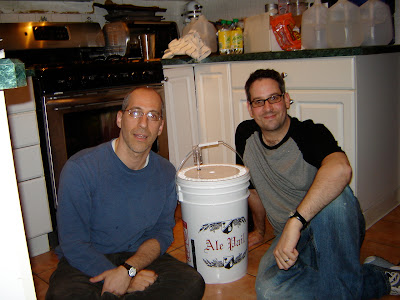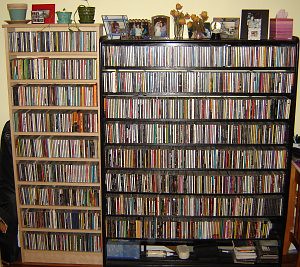At 12:28pm on Saturday, October 4, 2008, Nahum and I lit the fire under our inaugural pot of homebrew. I know the exact time because it's a specific part of my job in the process: to take notes, keep track and document the process (see: the page you're reading right now).
And I now have a page of notes regarding our 1st crack at making beer. Prepping the 5 gallons of American Amber Ale took almost exactly 3 1/2 hours, a very fine way to pass a Saturday afternoon. Nahum is a veteran of endeavors like this, having already made his own cheese, his own (kosher) sausage, his own apple butter...you get the idea. The man already had most of the right equipment and all of the right attitude for home brewing - at each stage, as we followed the step-by-step instructions included in our American Amber kit, Nahum took a moment to take in the smells of the ingredients and notice the changes in color, consistency, etc.
But I'm getting ahead of myself. We started by sanitizing our equipment, putting 8 oz. of crushed crystal 60L malt into a muslin sock, and heating it in the pot, kind of like a giant tea bag that steeps beer (if only!). Then 2lb of dry malt went into the pot as we kept it at a steady boil for 55 minutes, after which 1 oz. of Willamette Bittering Hops went into the mix. [UPDATE: As Nahum pointed out, " Just prior to the 2lbs of dry malt, we poured 3.3 lbs of Munton's amber malt syrup."]
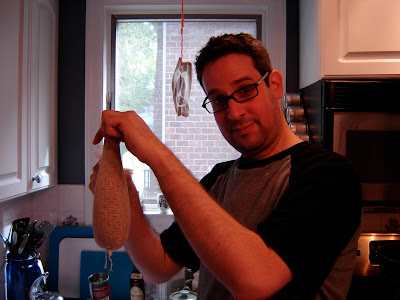
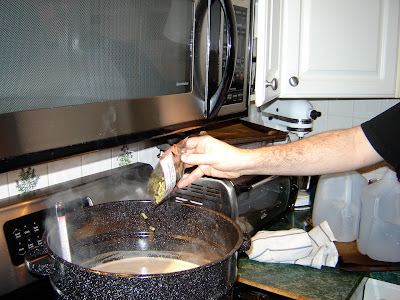
By this point, the pot was giving off a very strong, and very specific, smell: malty, yes, but also noticeably earthy...kind of like cereal covered in moss (especially after another 8 oz. of finishing hops went in). We had no real way of knowing if this was the smell it was
supposed to have, but it did seem to be a sort of logical alchemical combination of the individual ingredients' scents. So far so good, then.
After the boil, we had to get the temperature of the wort (the technical term for the liquid at this stage) from 220 degrees to 70 degrees as fast as possible. Nahum devised an ice bath in the sink, and we plunged the pot while keeping the liquid in motion to spread out the temperature. And in just 16 minutes...we'd done it! Comfortably cool wort.
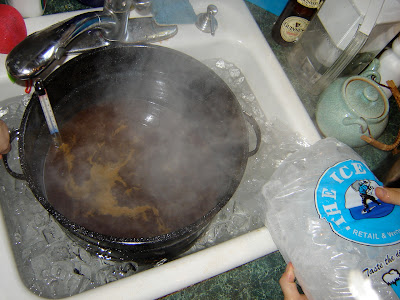
Now, we technically won't have any beer to drink for another couple of weeks...but you didn't think we'd actually wait that long, right? Perish the thought. Nahum and I sampled the lukewarm wort, and it tasted like...well, it didn't taste like beer yet. But it was certainly a
beer-related flavor, bitter and still very earthy.
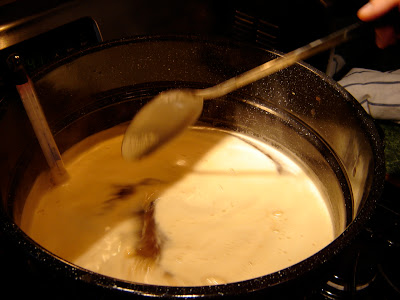
Next came the most science-ish part of the process: taking a specific-gravity reading. Now, my relationship with science is tense, at best; when it comes to explaining the reasons behind how the beer works, I'm more on the Homer Simpson tip: "
Fire made it good." But I soldiered on, dropping the hydrometer into the bucket (which we'd filled with more science-related activity involving a long-hosed siphon) and taking the reading.

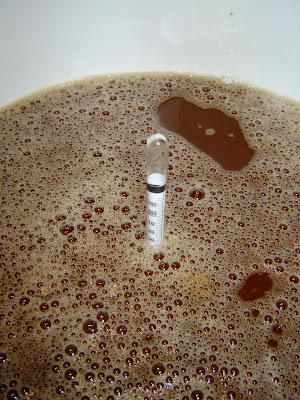
And wouldn't you know it: 1.040. Which, according to the recipe, is right about where it should be. As we added the yeast and sealed up the bucket to let it ferment for a week, we both noted that somewhat to our mutual surprise, everything had gone as it should. Each step took about as long as the recipe and books and websites said it should, and each result seemed to be as it was supposed to be.

As Gov. Palin might put it: "Doggone it, we might be able to give Joe Six-Pack some beer here, folks." And we just might, after the bucket ferments for a week, and we head back to the Two Jews Lab for the next step(s).
